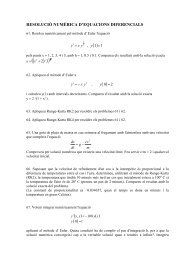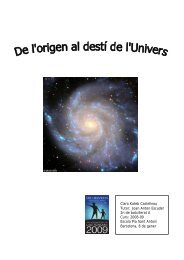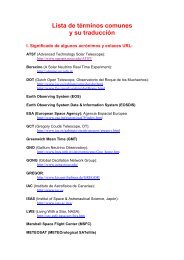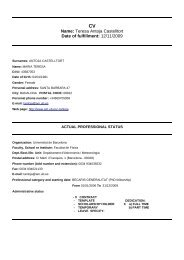Universitat de - Departament d'Astronomia i Meteorologia ...
Universitat de - Departament d'Astronomia i Meteorologia ...
Universitat de - Departament d'Astronomia i Meteorologia ...
You also want an ePaper? Increase the reach of your titles
YUMPU automatically turns print PDFs into web optimized ePapers that Google loves.
156 Chapter 6. EVN and MERLIN observations<br />
Table 6.5: Mo<strong>de</strong>l fitted positions of the components in the 1RXS J001442.2+580201<br />
radio jets and obtained jet parameters.<br />
Comp. Distance P.A. βmin θmax<br />
[mas] [ ◦ ] [ ◦ ]<br />
N1 8.6 ± 0.3 2 0.23 ± 0.02 77 ± 1<br />
N2 3.6 ± 0.2 −10 0.16 ± 0.02 81 ± 1<br />
S2 5.0 ± 0.1 177 0.16 ± 0.02 81 ± 1<br />
S1 13.7 ± 0.3 177 0.23 ± 0.02 77 ± 1<br />
nents are present southwards, one (S2) of 1.1 mJy at 5.0 mas (P.A. 177 ◦ , FWHM of<br />
0.8 mas) and the other one (S1) of 0.4 mJy at 13.7 mas (P.A. 177 ◦ , FWHM below<br />
0.3 mas).<br />
If we assume that components S1 and N1 correspond to a pair of plasma clouds<br />
ejected at the same epoch near the compact object and perpendicularly to the<br />
accretion disk, we can estimate some parameters of the jets by using the following<br />
equation:<br />
β cos θ = µa − µr<br />
µa + µr<br />
= da − dr<br />
da + dr<br />
, (6.1)<br />
β being the velocity of the clouds in units of the speed of light, θ the angle between<br />
the direction of motion of the ejecta and the line of sight and µa and µr the proper<br />
motions of the approaching and receding components, respectively (see Sect. 1.2.1).<br />
Although we do not know the epoch of ejection of the clouds, we can cancel the<br />
time variable by using the relative distances to the core da and dr, as expressed in<br />
Eq. 6.1. Since both variables, β and cos θ, take values between 0 and 1, it is clear<br />
that knowing β cos θ allows us to compute a lower limit for the velocity (βmin) and<br />
an upper limit for the angle (θmax). The same applies for the S2 and N2 components.<br />
In Table 6.5 we list the positions of the components obtained from mo<strong>de</strong>l fitting,<br />
together with the <strong>de</strong>rived values from βmin and θmax for each one of the pairs. The<br />
slightly different results obtained using pair 1 or 2, could be due to the fact that<br />
the position for the S1 component obtained with mo<strong>de</strong>l fitting happens to be at<br />
the lower part of this elongated component, hence increasing β cos θ, or to intrinsic<br />
different velocities for each one of the pairs. Hereafter we will use β > 0.20 ± 0.02<br />
and θ < 78 ± 1 ◦ .<br />
A similar approach to obtain the jet parameters of the source can be performed






